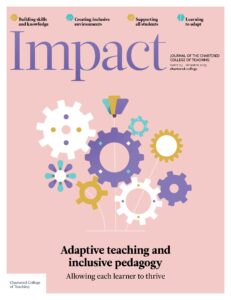From the editor

Dr Chandrika Devarakonda, University of Chester, UK
DiversityThe recognition of individual differences in terms of race, ethnicity, gender, sexual orientation, socio-economic status, physical ability, religious beliefs and other differences and difference among learners should be acknowledged, accepted and appreciated to enable better outcomes for all. For educators, this entails adaptation of both the curriculum and learning approaches, appropriate to the varying needs of children within a class and within a school or college.
Generally, diversity is identified in line with the characteristics of a learner’s ethnicity, cultural background, socioeconomic status, gender, languages spoken and any special educational needs and disabilities. However, it is crucial to understand that diversity is heterogenous (Abascal et al., 2021) and so children who are visibly or ostensibly similar may have differing needs. Visible diversity can reinforce stereotypes related to individual characteristics, which may overlook any nuanced and specific individual needs (Devarakonda, 2021).
Such diverse needs and characteristics might be hidden, and may include varying linguistic abilities, cultural and religious beliefs, socioeconomic contexts and learning abilities. These aspects can be unwittingly overlooked by schools due to lack of awareness, unconscious biases and the influence of systemic inequalities. It is important to be aware of the diversity of the diversities that surround us in educational settings, so that the needs of children are not masked as a result of assumptions related to familiar categories, and perhaps due to a lack of awareness of the sheer range of needs and the possible adaptations that can be made to support all learners to thrive both individually and together.
Special educational needs and disabilities (SEND) presents us with a big umbrella term that can encompass a wide array of needs and abilities. Learners with SEND can have a mild, moderate or severe physical disability and/or specific special educational needs, which cover a broad spectrum of neurodivergent conditions. It is important to be aware of how such labels might affect a child’s growth and development. Holistic needs should be considered while avoiding homogenisation, and, where possible, provision and resources should be adapted according to the unique and varying needs of all children.
The Wheel of InclusionAn approach where a school aims to ensure that all children are educated together, with support for those who require it to access the full curriculum and contribute to and participate in all aspects of school life (Devarakonda, 2020) is a model that builds on the ideas that inclusion is dynamic and a joint effort of people (staff) and policy at various layers of hierarchy in educational institutions, and in the community at local, regional, national and sometimes international levels. It is crucial for the Wheel of Inclusion to be in motion and collectively enabled by all school-based staff, professionals and leaders, by family members, by peer groups in the classroom, and also by those influential community members in local contexts. The Wheel of Inclusion strongly emphasises building on an individual’s existing strengths, leading to a sense of belonging and, eventually, positive outcomes for all children.
This issue of Impact includes articles that focus on the ways in which both the curriculum and learning activities are adapted to meet the needs of all children, including but not limited to those with SEND, children with English as an additional language, children from disadvantaged families, and those with social, emotional and mental health (SEMH) difficulties, behavioural challenges, and speech and language needs. Within these pages, there are inspiring examples of excellent practice from schools, highlighting successful and innovative strategies that have been used with children with wide-ranging needs and levels of ability. Some authors discuss how adaptive strategies have been shared in order to enhance the professional development of teachers and support staff across a school, while others show how good practice can be extended throughout schools in multi-academy trusts (MATs), through collaboration, research-engagement, reflective practice and peer-learning.
Malpas reports on an action research project that helped Year 3 students with SEND to improve their learning through a narrative approach. The pedagogical tool of collaborative storytelling enabled young children to develop their critical thinking skills, using imagination to enable them to retain learning on Roman history.
Horton examines the ideas developed by the Education Endowment Foundation that have enhanced pastoral systems and promoted inclusive practice around SEMH needs for children with behavioural issues. Bullock and Brining share how assemblies in secondary schools have integrated evidence-based psychoeducation: students discussed psychological concepts, supported by their personal narratives. These kinds of discussion are capable of reducing stigma and promoting the development of empathy and emotional self-regulation among our young people.
The importance of art and music for children with SEND is promoted by Thompson, who suggests that by focusing on learners’ strengths in these areas, inclusion can be reinforced. Fabian highlights the value of using music therapy to support social and emotional development in children. Lewis describes an oracy project that enables Year 7 children with speech, language and communication needs to progress, leading to improved outcomes. Another interesting approach, called Shape Coding, is explored by Dirir, Qureshi and Grenier, who use a visual system that links shapes and colours to teach English grammar and abstract language. This is especially useful for not only children with SEND but also refugee children with poor English skills, who might join school mid-year and must adapt quickly to English education.
Rowley and Parr have introduced an initiative to improve student outcomes across their MATMulti-academy trust - a group of schools working in collaboration, governed by a single set of members and directors, in which adaptive teaching strategies such as explicit instruction, cognitive and metacognitive strategies, scaffoldingProgressively introducing students to new concepts to support their learning, and flexible grouping using technology, are used consistently across all schools and classrooms. Trickey et al. explain how beginning teachers are empowered to be agents of change by relating to inclusion beyond SEND and celebrating diversity by adapting strategies according to individual and unique needs. Johnson and Horn describe a collaborative approach to SEND provision, involving support staff through a learning coach workforce model.
Bailey, Curtis and Davies have redesigned SEND provision by developing pupil passports with learning needs and linking to provision maps. Cottinghatt et al. discuss coaching that develops teachers’ mental models and decision-making processes that are adaptive and sensitive to contextual cues observed in the classroom. In a different economic and cultural context, Parashar refers to context-sensitive teaching strategies and learner-centred approaches such as storytelling, action songs and interactive discussions to develop English competence in young children from disadvantaged backgrounds in India.
The articles presented in this issue, including those featured in the online edition, bring together a selection of thought-provoking approaches that highlight how adapting our thinking and our teaching to accommodate the differences and needs of learners can positively affect outcomes and create a positive and inclusive learning environment for all students and staff. The good practice related to adapted strategies developed by schools provides opportunities to unlearn and relearn perspectives related to how the individual needs of children from diverse backgrounds are met to produce positive outcomes for all.
- Abascal M, Xu J and Baldassarri D (2021) People use both heterogeneity and minority representation to evaluate diversity. Science Advances 7(11): eabf2507.
- Devarakonda C (2020) Promoting Inclusion and Diversity in Early Years Settings: A Professional Guide to Ethnicity, Religion, Culture and Language. London: Jessica Kingsley Publishers.
- Devarakonda C (2021) Joining the Dots of Diversity and Inclusion in Early Childhood. The Foundation Stage Forum, November 10, 2021. Available at: https://eyfs.info/articles.html/teaching-and-learning/joining-the-dots-of-diversity-and-inclusion-in-early-childhood-r377 (accessed 28 April 2025).










